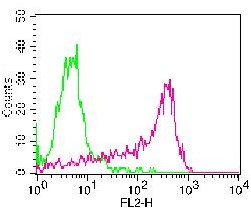Anti-CD20 Monoclonal Antibody (Clone:MEM-97)

Figure 1:Immunoprecipitation of human CD20 from the whole cell lysate of RAJI human Burkitt lymphoma cell line.Western blot was immunostained with anti-CD20 rabbit polyclonal antibody. Lane 1: original lysate of RAJI cells. Lane 2: immunoprecipitate by Isotypic mouse IgG1 control (PPV-06; ). Lane 3: original lysate of RAJI cells. Lane 4: immunoprecipitate by anti-CD20 (MEM-97)
Roll over image to zoom in
Shipping Info:
For estimated delivery dates, please contact us at [email protected]
| Format : | Purified |
| Amount : | 0.1 mg |
| Isotype : | Mouse IgG1 |
| Purification : | Purified by protein-A affinity chromatography |
| Storage condition : | Store at 2-8°C. Do not freeze. |
CD20 is a cell surface 33-37 (depending on the degree of phosphorylation) kDa non-glycosylated surface phosphoprotein expressed on mature and most malignant B cells, but not stem cells or plasma cells (low number of the CD20 has been also detected on a subpopulation of T lymphocytes and it can be expressed on follicular dendritic cells). Its expression on B cells is synchronous with the expression of surface IgM. CD20 regulates transmembrane calcium conductance (probably functioning as a component of store-operated calcium channel), cell cycle progression and B-cell proliferation. It is associated with lipid rafts, but the intensity of this association depends on extracellular triggering, employing CD20 conformational change and/or BCR (B cell antigen receptor) aggregation. After the receptor ligation, BCR and CD20 colocalize and then rapidly dissociate before BCR endocytosis, whereas CD20 remains at the cell surface. CD20 serves as a useful target for antibody-mediated therapeutic depletion of B cells, as it is expressed at high levels on most B-cell malignancies, but does not become internalized or shed from the plasma membrane following mAb treatment.
Flow cytometry: Recommended dilution: 1-5 μg/ml.
For Research Use Only. Not for use in diagnostic/therapeutics procedures.
| Subcellular location: | Cell membrane, Cell membrane |
| Post transnational modification: | Phosphorylated. Might be functionally regulated by protein kinase(s). |
| Tissue Specificity: | Expressed on B-cells. |
| BioGrid: | 107369. 15 interactions. |
|
There are currently no product reviews
|























.png)









